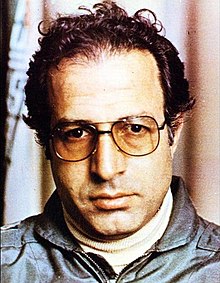Javad Fakouri (Persian: جواد فکوری; 3 January 1936 – 29 September 1981) was an Iranian prominent military figure who served as the 4th defence minister of Iran in September 1980 to August 1981.
Javad Fakoori | |
|---|---|
 | |
| Born | 3 January 1936 Tabriz, Pahlavi Iran |
| Died | 29 September 1981 (aged 45) Kahrizak, Iran |
| Allegiance | Iran |
| Service/ | Air Force |
| Years of service | 1958–1981 |
| Rank | Colonel[1] Major General (posthumous) |
| Commands held | 2nd Tactical Air Base 1st Tactical Air Base Islamic Republic of Iran Air Force |
| Battles/wars | |
| Awards | |
| Minister of National Defense | |
| In office 10 September 1980 – 17 August 1981 | |
| Prime Minister | Mohammad-Ali Rajai |
| Preceded by | Mostafa Chamran |
| Succeeded by | Mousa Namjoo |
Career
editFakoori was a commander of the Islamic Republic of Iran Air Force at the rank of colonel. He entered the Iranian Air Force in 1958 as a fighter pilot of the F-100. He later qualified on the F-4 fighter-bomber in 1967. He commanded a flight, squadron, wing and group of F-4 aircraft during the Pahlavi regime. In 1978, he was promoted to colonel and stationed in Tehran as a staff officer. Despite the fact that one of his cousins was a leading member of the MEK and had sought asylum in Sweden in 1980, he had the confidence of Khomeini and Rafsanjani.[2] With the consent of Khomeini, then-president Abolhassan Banisadr appointed him to this post in June 1980.[3][4]
Fakoori was the commander of the Iranian Air Force during the Iran–Iraq War. He also served as the Iranian defence minister from spring 1981 to September 1981.[5] Fakoori replaced Mostafa Chamran as defence minister when the latter died in a plane crash accident during the Iran–Iraq war. Mohammad Salimi replaced Fakoori as defence minister in 1981.[5]
Death
editFakoori and other senior military officials, including Valiollah Fallahi and Mousa Namjoo, were killed in a crash near Tehran on 29 September 1981.[5] Ayatollah Ruhollah Khomeini made a speech following the incident in which he implied the Mujahedeen Khalq as the perpetrator without clearly condemning the leftist group.[6]
Fakoori was posthumously promoted to the rank of major general.
References
edit- ^ Nikola B. Schahgaldian, Gina Barkhordarian (March 1987), The Iranian Military Under the Islamic Republic (PDF), RAND, ISBN 0-8330-0777-7, retrieved 15 January 2017
- ^ Ehteshami Anous (1995). After Khomeini: The Iranian Second Republic. Routledge, Chapman & Hall, Incorporated. p. 22. ISBN 978-0-415-10879-9. Retrieved 17 February 2013.
- ^ Dilip Hiro (1987). Iran Under the Ayatollahs. Routledge & Kegan Paul. pp. 156. ISBN 978-0-7102-1123-1. Retrieved 17 February 2013.
- ^ "Iranian military chiefs reshuffled". Spokane Daily Chronicle. Associated Press. 19 June 1980. Retrieved 27 August 2013.
- ^ a b c Sepehr Zabir (23 April 2012). The Iranian Military in Revolution and War (RLE Iran D). CRC Press. p. 277. ISBN 978-1-136-81270-5. Retrieved 17 February 2013.
- ^ "Crash kills four top Iranian officers". The Daily Egyptian. Vol. 66, no. 29. Beirut. Associated Press. 1 October 1981. Retrieved 7 August 2021.
External links
edit- Media related to Javad Fakori at Wikimedia Commons